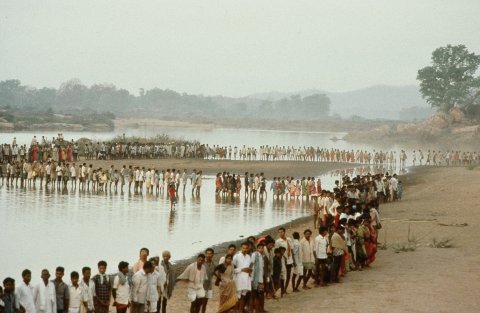DEFENDING A RIVER: FIGHTING AGAINST THE BIG DAMS

A huge ‘rally for the valley' that was organized by the NBA to
protest against the construction of the Sardar Sarovar dam on the Narmada river in 1999.
BY GAURAV DIKSHIT
This is a fascinating tale of an environment organization in India which is fighting a losing battle against big dams but continues to inspire others with its noble failure
The Narmada Bachao Andolan, or the Save Narmada Movement, is an organization formed in 1989 as a broad coalition of people affected by a project to build a series of dams on the Narmada river in central India.
The organization is reasonably well known internationally, as it has held demonstrations in cities such as Denver and Washington.
It began as a protest against the resettlement and rehabilitation package – the ‘R&R Package' -- offered by the government to people whose land would be submerged in the dams' reservoirs.
Rehabilitation only on paper
The R&R package promised to compensate such displaced people through land or cash, but the protestors said that the package existed only on paper: displaced people were either being given barren land or no land at all, and the cash compensation was a joke.
The NBA, as the organization is popularly known, adopted a strategy similar to Mahatma Gandhi's -- non-violent civil disobedience, hunger strikes, and going to court.
It organized massive demonstrations that caught the eye of the international media. The World Bank was funding part of the project; it sent to India an independent review commission (a first for a World Bank project) and the commission damned the R&R package, forcing the embarrassed government to let go of the bank's money.
In 2000, the NBA suffered a major defeat when India's Supreme Court said that the height of Sardar Sarovar, the biggest of the proposed 30 major dams, can be raised. But a slew of cases are still stuck in the courts, and so is the construction work of most major dams.
What had the dams done?
Over time, the NBA grew from a demand for a better R&R package to a radical questioning of the idea of big dams.
It acquired a strong environmental voice, arguing for the right to life of an entire ecology sustained and shaped by a river.
The people whom the dams would displace were mostly tribals, their livelihoods dependent on the forest and the river, and the NBA wanted their traditional way of life to be protected.
The NBA documented how India's existing big dams had destroyed soil fertility, turned groundwater saline, and delivered vastly less than promised benefits. The NBA began to demand the scrapping of the big dams' project.
The Narmada looks on a map of India as the equator looks on a map of the world: it is a line almost exactly in the middle.
The Narmada is also a sacred river, rivers generally being an object of worship in India. But the NBA has never evoked religion; its opposition to the dams has consistently grown more ideological: against the superimposed idea of development, and for the age-old right of people, plants and animals to their earth and water.
This has earned the NBA few friends among the middle class, and almost none in the media.
Facing media scorn
Both national and regional media have portrayed the NBA as anti-modernity and anti-development and lampooned the protestors as Luddites.
The heroic nature of the resistance – poor tribal and peasant people stoically and non-violently standing firm for 20 years against often horrific police brutality, virulent media propaganda and a nexus of corporate-political interests trying to profit from the dams – has seldom found mention.
Protestors have been jailed, beaten, harassed and sometimes killed, but never has the NBA resorted to a violent act.
Meanwhile, the media has lost interest in the issue and court judgements are beginning to come in favour of the dams.
The protestors have grown more desperate: they stand amid the rising water when a reservoir begins to be built, prepared to drown but not to vacate their ancestral land. But many of even the oldest NBA members have begun to concede that they are fighting a losing battle.
Inspiring others
Even as the NBA is dying, its cause has found a new life in several recent anti-dam movements across India.
A proposed dam on India's most sacred river, the Ganga, has drawn the ire of influential Hindu religious leaders and their followers.
The BJP, India's No.2 national political party and with a predominantly Hindu support base, has thrown its weight behind the protestors.
A number of proposed dams in India's insurgency-torn northeast is being seen by locals as New Delhi's takeover of the region's natural resources.
A magnum opus proposal to artificially link India's major rivers has been too much to digest even for the middle classes, and the plan has died a natural death. The NBA continues to inspire by example, its failures a lesson in themselves.
Gaurav Dikshit researched the Narmada Bachao Andolan for an M.Phil dissertation, which was never completed, at the Centre for Historical Studies, Jawaharlal Nehru University, New Delhi. When he quit academics and joined The Indian Express, a newspaper he had never read, he went to an NBA sit-in protest in Delhi and was met by scorn and anger. It was then that he discovered that The Indian Express regularly ran down and mocked the NBA. This, he soon found, was common in most mainstream media, and part of a pattern: the effacing of genuine mass struggle from the news agenda.